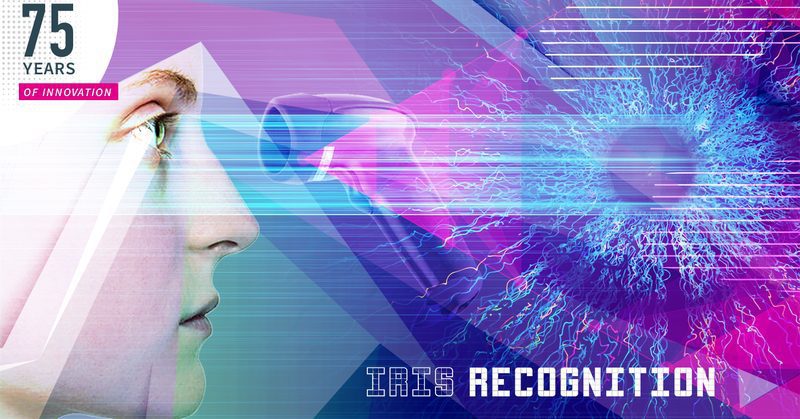The 75 Years of Innovation series highlights the groundbreaking innovations spanning from SRI’s founding in 1946 to today. Each week, SRI will release an innovation, leading up to its 75th anniversary in November 2021.

The ability to use iris recognition in real-life scenarios by removing previous constraints
In a blink of an eye: How SRI captured your Iris On the Move (IOM)
When you look into someone’s eyes what do you see? I wager you say the iris, that circle of color in the human eye that is so engaging. The iris plays a crucial role in our sight. If you shine a light into an eye, the muscles that are part of the iris contract. If you walk into a darkened room, the iris muscles expand to allow more light in to help you see.
An iris has another special feature. Like a fingerprint, an iris presents a unique pattern. This allows the iris to be used as a biometric providing a way to uniquely identify a person. In 2006, Sarnoff Corporation (now part of SRI International) developed an innovation in iris recognition that would make the technique much more commercially viable.
Here, the spotlight is placed on the Iris on the Move® (IOM) technology.
Opening the eyes of the world to iris recognition on the move
Iris recognition was not a new discipline when Sarnoff developed its “Iris on the Move®” (IOM) technology. As early as the 1930s, ophthalmologist Frank Burch suggested that an iris could be used in the identification of an individual. In 1995, the first commercial products using iris recognition became available. These were based on patented algorithms by J.G. Daugman.
However, iris recognition, at that point, had some serious constraints. Earlier systems required an individual to be in a fixed position and placed at a specific angle, close enough to capture the iris image. In other words, the capture of the unique pattern of a given iris was dependent on the individual being static. These constraints were not caused by the iris recognition algorithms, rather the image capture itself restricted the capabilities of the technology. They also presented commercial issues in the types of use cases iris recognition could be used for.
This latter issue in image capture — requiring a user to be in a fixed position and close to the camera — became a focus for researchers at Sarnoff Corporation; Dr. Matey and his research team at Sarnoff, led the efforts to resolve this. This team went on to develop an image capture system that used high-resolution cameras, video synchronized strobed illumination and specularity based image segmentation.
An iris recognition system that was on the move
Iris recognition technology is an accurate and secure method of identifying an individual. The assurance that the recognition of an individual is correct is higher than that of a fingerprint, for example. The problem with biometric factors, such as with fingerprints, is that fingerprint scanners rely on contact and can quickly become dirty, requiring regular maintenance. Whereas eyes are ‘self-cleaning’, and iris scanners can work at a reasonable distance. Other factors in creating commercially viable biometric identification systems include ease of use, ease of deployment and cost.

But older iris scanners, as mentioned, had the dual constraints of fixed position and close distance: These iris scanners could not be used for people who were walking or if a person was at a far distance. It was the use of iris recognition in real-world scenarios that Sarnoff worked to resolve. The IOM system was in prototype by 2006. In 2008, Sarnoff demoed its “Drive-Through and new Compact Iris on the Move® (IOM)” iris capture system at the Biometric Consortium Conference in Florida. In 2009, the IOM system was tested out at Schiphol airport in the Netherlands. The IOM system was able to verify individuals by scanning irises from a distance as they moved through security checks. The IOM system was shown to identify individuals at speeds of up to 30 people per minute.
IOM in the palm of your hand
Since then, the Iris on the Move® (IOM) system has found major success. Commercial products based on the IOM technology include the IOM PassPort SL used for corporate lobbies and airports. In 2013, the Iris on the Move (IOM) PassThru system was shown to handle drive-up scenarios that were outdoors and in all lighting conditions. Drivers did not need to remove gloves, headgear, glasses or contact lenses and could remain in their car. In 2014, Samsung chose Iris on the Move technology as the access control mechanism in their mobile devices.
In 2016, SRI spun-out a company, Princeton Identity Inc., to take the IOM technology and develop it further. Since then, the IOM technology has been applied to sports venues, medical and healthcare applications as well as for border control across the world. In 2018, Princeton Identity’s solution, Access500e™, was deployed at Dubai International Airport, the system being able to process travelers within one to two seconds, providing security without affecting the overall travel experience.
Iris recognition, like many of the inventions borne of the SRI International stable, has been made into a commercially viable technology by taking advantage of SRI’s and associates’ expertise. Sarnoff Corp’s deep knowledge of image capture and high-resolution camera technology provided the necessary capability to take iris recognition algorithms and create innovations that work in real-life situations.
Resources
Interview with Steve Perna on IOM: https://www.biometricupdate.com/201512/sri-executive-discusses-iris-on-the-move-technology
J. G. Daugman, “High confidence visual recognition of persons by a test of statistical independence,” in IEEE Transactions on Pattern Analysis and Machine Intelligence, vol. 15, no. 11, pp. 1148–1161, Nov. 1993, doi: 10.1109/34.244676.
Matey, J. R., et.al., (2006). Iris on the Move: Acquisition of Images for Iris Recognition in Less Constrained Environments. Proceedings of the IEEE. 94. 1936–1947. 10.1109/JPROC.2006.884091.


